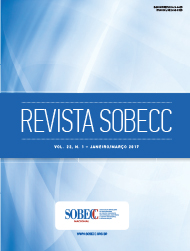Prevalence of and risk factors for surgical site infections in patients with myelomeningocele
DOI:
https://doi.org/10.5327/Z1414-4425201700010003Keywords:
enfermagem, centro cirúrgicoAbstract
Objective: To determine the prevalence of and risk factors for surgical site infections (SSIs) in the treatment of children with myelomeningocele.
Methods: The medical records of children who underwent the procedure were listed; only the cases that tested positive for SSI were analyzed.
Results: From 2005 to 2010, 155 medical records were listed, 123 (79.35%) of which were found. Of these, 14 (9.03%) were discarded, and 109 (70.32%)
remained for analysis. There was a 33.94% prevalence of SSIs; the lumbosacral localization (32.43%) and ruptured lesions (83.78%) are predominant.
The majority (86.49%) of the children underwent surgical correction after 48 hours of life. In 11 (27.73%) cases, material from the surgical wound was
cultured, all of them (100%) were positive; Klebsiella pneumoniae (46.66%) and Pseudomonas aeruginosa (26.67%) prevailed. Conclusion: The prevalence
rate of SSIs in this study was high when compared to other types of surgery; for infected surgeries, however, the levels found are consistent with the literature,
which reports from 7% to 40%.
References
Baghdadi T, Abdi R, Bashi RZ, Aslani H. Surgical management of hip
problems in myelomeningocele: a review article. Arch Bone Jt Surg.
;4(3):197-203.
Di Rocco C, Trevisi G, Massimi, L. Myelomeningocele: an overview.
World Neurosurg. 2014;81(2):294-5. Disponível em: http://www.
worldneurosurgery.org/article/S1878‑8750(13)00325‑2/abstract
Marreiros, H, Loff, C, Calado, E. Who needs surgery for pediatric
myelomeningocele? A retrospective study and literature review. J
Spinal Cord Med. 2015;38(5):626-40.
Bao N, Lazareff J. How I do it: management of spina bifida in a hospital in
The People’s Republic of China. Surg Neurol Int. 2015;6(Suppl 11):337-45.
Roscani ANCP, Ferraz EM, Oliveira Filho AG, Freitas MIP. Validação
de checklist cirúrgico para prevenção de infecção de sítio cirúrgico.
Acta Paul Enferm. 2015;28(6):553-65.
Nogueira PSF, Moura ERF, Costa MMF, Monteiro WMS, Brondi L. Perfil
da infecção hospitalar em um hospital universitário. Rev Enferm UERJ.
;17(1):96-101.
A gência Nacional de Vigilância Sanitária (ANVISA). Critérios
diagnósticos de infecção relacionada à assistência à saúde ‑ Série
Segurança do Paciente e Qualidade em Serviços de Saúde. 2013.
p. Disponível em:
index.php/publicacoes/category/livros>
Oliveira AC, Ciosak SI. Infecção de sítio cirúrgico em hospital
universitário: vigilância pós-alta e fatores de risco. Rev Esc Enferm
USP. 2007;41(2):258-63.
Demir N, Peker E, Gülsen I, Agengin K, Tuncer O. Factors affecting
infection development after meningomyelocele repair in newborns and
the efficacy of antibiotic prophylaxis. Childs Nerv Syst. 2015;31(8):1355-9.
Salomão JF, Pinheiro JAB, Carvalho JGS, Leibinger RD, Lucchesi
G, Bomfim V. Mielomeningocele: tratamento cirúrgico e resultados.
Jornal de Pediatria. 1995;317-21. Disponível em: http://www.jped.
com.br/conteudo/95‑71‑06‑317/port.pdf.
Schroeder HK, Nunes JC, Madeira L, Moritz JLW, Walz R, Linhares MN.
Postsurgical infection after myelomeningocele repair: a multivariate analysis of
consecutive cases. Clinical Neurology and Neurosurgery. 2012;114(7):981-5.
Bellusse GC, Ribeiro JC, Campos FR, Poveda VB, Galvão CM. Fatores
de risco de infecção da ferida operatória em neurocirurgia. Acta Paul
Enferm. 2015;28(1):66-73.
Pinto NC, Pinto FCG, Alho EJL, Yoshimura EM, Krebs VL J, Teixeira
MJ, et al. Estudo piloto em neonatos utilizando o laser de baixa
intensidade no pós-operatório imediato de mielomeningocele.
Einstein (São Paulo). 2010;8(1):5-9.
A nteby EY, Yagel S. Route of delivery of fetuses with structural
anomalies. Eur J Obstet Gynecol Reprod Biol. 2003;106:5-9.
Faraji M, Ashrafzadeh F, Ariamanesh A, Faraji S. Surgical outcome
of patients with meningomyelocele treated with a team approach.
Neurosurgery Q. 2006;16(2):160-7.
Bratzler DW, Dellinger EP, Olsen KM, Perl TM, Auwaerter PG, Bolon
MK, et al. Clinical practice guidelines for antimicrobial prophylaxis
in surgery. Am J Health Syst Pharm. 2013;70(3):195-283.
Olson MM, Lee JT. Continuous, 10-year wound infection surveillance.
Ann Surg. 1990;60:27-40.
Kshettry VRI, Kelly ML, Rosenbaum BP, Seicean A, Hwang L,
Weil RJ. Myelomeningocele: surgical trends and predictors of
outcome in the United States, 1988-2010. J Neurosurg Pediatrics.
;13(6):666-78.
Radcliff E, Cassell CH, Laditka SB, Thibadeau JK, Correia J, Grosse
SD, et al. Factors associated with the timeliness of postnatal surgical
repair of spina bifida. Childs Nerv Syst. 2016;32(8):1479-87.
Garcia LM, César ICO, Braga CA, Souza GAAD, Mota EC. Perfil
epidemiológico das infecções hospitalares por bactérias
multidrogarresistentes em um hospital do norte de Minas Gerais.
Rev Epidemiol Control Infect. 2013;3(2):45-9.
Downloads
Published
How to Cite
Issue
Section
License
By publishing in Revista SOBECC, authors retain the copyright of their article and agree to license their work using a Creative Commons Attribution (CC BY 4.0) International Public License, thus accepting the terms of this license. The CC BY 4.0 license allows others to distribute, remix, adapt, and create from the published article, even for commercial purposes, provided they give due credit to the creators of the work (authors of the article).
The authors grant to Revista SOBECC the right of first publication, to identify itself as the original publisher, and grant to the journal a non-exclusive license to use the work in the following ways: (1) to sell and/or distribute the article in hard copies and/or in electronic format; (2) to distribute parts and/or the entire article in order to promote the journal through the internet and other digital and printed media; (3) to record and reproduce the article in any format, including digital media.
With this license, authors can enter into separate contracts for non-exclusive distribution of the article (e.g., publishing in an institutional repository or as a book chapter), with acknowledgement of authorship and initial publication in Revista SOBECC. Authors are encouraged to publish and distribute their work online after publication in the Revista SOBECC, as this can increase the article's visibility and impact.
In line with the journal's policies, each published article will be assigned a CC BY 4.0 license, which will be visible on the abstract page and in the PDF of each article with the respective link to the license terms.











